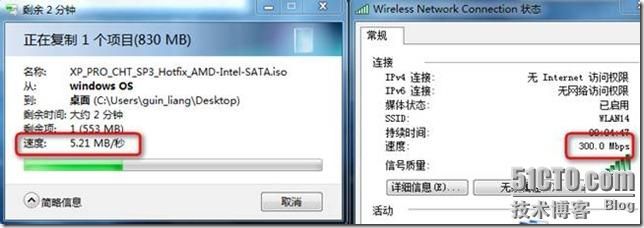TEST 802.11n on CISCO WLC
Overview 802.11n
Wireless networks are widely deployed in industrial and domestic environments. New applications are emerging to meet customer needs. Many of these applications are bandwidth intensive. Multimedia applications require more bandwidth for improved performance. 802.11n addresses these challanges by providing throughput as high as 600 Mbps. It also provides better reliability and coverage when compared to existing 802.11 a/b/g technology.
802.11n can operate either in 2.4 or 5 GHz. They are interoperable with existing 802.11a or 802.11 b/g technologies. This section provides an overview of how 802.11n works. Currently, 802.11n is supported in Cisco 1250 series APs and Cisco 1140 series APs.
Various techniques are employed in 802.11n to provide higher data rates and better coverage. the techniques used on WLC as below.
MIMO: In the existing 802.11 a or 802.11 b/g technologies, transmission and reception of data streams usually happen using only one of the antennas. However, in 802.11n data streams can be transmitted and received over both the antennas. This results in a greater number of bits transmitted and received at a given point of time, effective usage of multipath signals which is usually a problem in indoor coverage. This leads to increased throughput and wider coverage.
Channel Bonding: The amount of data that can be transmitted also depends on the width of the channel used in data transmission. By bonding or combining two or more channels together, more bandwidth is available for data transmission. In 2.4 and 5 GHz frequency band, each channel is approximately 20 MHz wide. In 802.11n, two adjacent channels, each of 20 MHz are bonded to get a total bandwidth of 40 MHz. This provides increased channel width to transmit more data. Cisco does not support channel bonding in 2.4 GHz frequency (802.11 b/g), because only three non-overlapping channels 1, 6 and 11 are available. However, the channel bonding has more relevance in 5 GHz frequency range where you have as many as 23 adjacent non-overlapping channels currently available. Channel bonding is supported only in 5 GHz, for example 802.11a.
Frame Aggregation with A-MPDU: In 802.11, after transmission of every frame, an idle time called Interframe Spacing (IFS) is observed before transmitting the subsequent frame. In 802.11n, multiple packets of application data are aggregated into a single packet. This is called A-MPDU (Aggregated - MAC Protocol Data Unit). This reduces the number of IFS, which in turn provides more time for data transmission. In addition, clients operating in 802.11n send acknowledgement for block of packets instead of individual packet acknowledgement. This reduces the overhead involved in frame acknowledgements and increases the overall throughput.
Decreased Timers: In 802.11n, few timers have been reduced to decrease the idle time between individual frame transmissions
Configure 802.11n on WLC and client
Configure 802.11n on CISCO WLC. Too much Configuration sectional drawing , here omitted, the key is to do the following:
- 802.11n requires AES encryption to be enabled on WLANs used by 802.11n clients. You can use a WLAN with NONE as Layer 2 Security. However, if you configure any Layer 2 security, 802.11n requires WPA2 AES enabled to operate at 11n rates.
- Make sure the AP has enough power. Lower power on the AP results in lower signal strength, which decreases the throughput.
- Make sure the 802.11n rates are enabled. MCS rates should be enabled (this is recommended to keep all of the MCS rates enabled).
- Make sure that the AP has 2 external antennas to avail the data rates
- Ensure that WMM is set to Allowed on the WLAN profile in order to achieve 802.11n rates.
- Make sure that the LAP has joined the controller and all radios are up.
- Make sure that the WLAN is enabled and configured to All under Radio Policy in order to operate in both 2.4 GHz and 5 GHz band.
Configure the Client for 802.11n
Make sure you use the client wireless card that supports 802.11n, here take wireless card intel 5300AGN on a windows7 for example
- 802.11n mode choose enable
- Wireless mode choose 802.11a/b/g
- 802.11n channel width for band choose auto
- Fat channel intolerant choose disable
- Throughput enhancement choose enbale
Verify
Check the connection status, speed and mode of a client both from the client and the WLC.
可以看出經過配製後的intel 5300A/G/N網卡能識別到無線網路WLAN14有802.11A/G/N三種協定支援連接。從連接後的速度可以看出連接的是802.11n,這個也能從下面WLC上的截圖看出。而如果client不支援802.11n,也可以連接AP正常使用,如下截圖除紅色框內的連接WLC上的client部分。即支援802.11n的AP只要配置802.11a/b/g/n,支援這裡任意協定的無線網卡都能連,不存在相容性問題。且不需要升級WLC或AP的IOS版本。
TEST report
Copy file test
在生產環境中copy the same file use 802.11n and 802.11a,the speed as below:
環境設備為CISCO WLC4402+LAP1252+3個2.4dbi 2.4GHz antenna + 3個3.5dbi 5GHz antenna
802.11n:無線連線速度為300Mbps,copy速度大概為5.21MB/S
802.11a:無線連線速度為54Mbps,copy速度大概為2.45MB/S
在測試環境中802.11n的拷貝檔速率(測試環境架構為千兆交換機接測試AP,千兆口測試NB,網線都為cat6)
802.11n:無線連線速度為300Mbps,copy速度為大概為13.0MB/S
可以看出在生產環境中802.11n的實際速度是802.11a的兩倍多,在測試環境中802.11n的速度只能達到13MB/S=104Mbps,生產環境中網絡有段位百兆帶寬,故和測試環境有大的差別。關於測試環境只有104Mbps 達不到理論上的300Mbps,後面的測試環境壓力測試也最多只能達到109.290Mbps。不過能達到這樣的速度已經很不錯了,已經比有線百兆網卡快了。關於為什麼達不到理論值,研究了下,在不使用channel bonding技術,理論速度為144Mbps時進行hight performance throughput實際最多也只能達到79.602Mbps如下截圖。這個原因是無線網絡中固有的,和AP 的設計工作模式有關係,AP是個半雙工的且無線傳輸時候協議開銷也很大。
High Performance Throughput
測試環境設備為CISCO WLC2106+LAP1252+3個2.4dbi 2.4GHz antenna + 3個3.5dbi 5GHz antenna
利用chairot在測試環境中對802.11n進行High Performance Throughput(壓力測試)。測試環境架構同上。
備註:
當WLC设置的SSID的认证方式為WEP時,因WEP技术的不安全性,將不能支持802.11N,所有的STA只能运作在最大54Mbps速率下
PS:最近实际又在测试这些,发现在w7下使用虚拟机测试的时候,测试实际无线吞吐量的时候总体跑不上去。具体原因还没有找到。所以以上CICSO的测试数据应该比得到的测试结果高,且以上测试的时候只用了一个pair,多复制几个流量也会上去点,当然再怎么上也估计在170Mbps吧.









